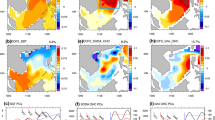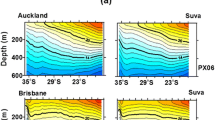Abstract
The decadal variability and long-term trend of upper-ocean temperature in the Southeast Indian Ocean since the 1950s are investigated based on an eddy-resolving ocean model and two observation-based products. All three datasets show increasing trends and significant decadal changes in both Southeast Indian Subantarctic Mode Water (SEISAMW) core layer temperature and mixed layer temperature (MLT). The temperature change in the SEISAMW core layer is induced by subducted heat change that is in turn due to a change in the MLT on both long-term trend and decadal time scale. A heat budget analysis finds that the long-term increase of MLT is mainly resulted from a combination of more heat flux from the atmosphere to the ocean and shallower mixed layer depth, while both the intensified zonal wind stress and the vertical entrainment have a negative contribution to the increase in the MLT. The decadal variability of MLT is dominated by changes of surface thermal forcing and horizontal advection, with the former contributing more than the latter. The change in the surface thermal forcing is a result of changes of both surface heat flux and mixed layer depth, and the change in the horizontal advection is due mainly to the change in the zonal wind stress. Further analysis suggests that the decadal changes of surface heat flux and zonal wind stress in the SEISAMW formation region are dominated by local zonal and meridional sea-level pressure gradients, respectively.














Similar content being viewed by others
Data availability
The 0.1° OFES output was provided by the Asia Pacific Data Research Center (http://apdrc.soest.hawaii.edu/dods/public_ofes/OfES/ncep_0.1_global_mmean).The Argo data were obtained from the Argo website (http://sio-argo.ucsd.edu/RG_Climatology.html). The EN4 data is available at https://www.metoffice.gov.uk/hadobs/en4/download-en4-2-1.html. The Ishii data is downloaded from https://rda.ucar.edu/datasets/ds285.3/. The NCEP1 is available at https://climatedataguide.ucar.edu/climate-data/ncep-ncar-r1-overview. The ERA5 product is obtained from https://climatedataguide.ucar.edu/climate-data/era5-atmospheric-reanalysis. The CORE2 is obtained from https://climatedataguide.ucar.edu/climate-data/corev2-air-sea-surface-fluxes.
References
Aoki S, Hariyama M, Mitsudera H, Sasaki H, Sasai Y (2007) Formation regions of Subantarctic Mode Water detected by OFES and Argo profiling floats. Geophys Res Lett 34(10):L10606. https://doi.org/10.1029/2007GL029828S
Aoki S, Mizuta G, Sasaki H, Sasai Y, Rintoul SR, Bindoff NL (2015) Atlantic-Pacific asymmetry of subsurface temperature change and frontal response of the Antarctic Circumpolar Current for the recent three decades. J Oceanogr 71(5):623–636. https://doi.org/10.1007/s10872-015-0284-6
Banks H, Wood R, Gregory J (2002) Changes to Indian Ocean subantarctic mode water in a coupled climate model as CO2 forcing increases. J Phys Oceanogr 32:2816–2827. https://doi.org/10.1175/1520-0485(2002)032%3c2816:CTIOSM%3e2.0.CO;2
Behera SK, Yamagata T (2001) Subtropical SST dipole events in the southern Indian Ocean. Geophys Res Lett 28(2):327–330. https://doi.org/10.1029/2000GL011451
Bindoff NL, Church JA (1992) Warming of the water column in the southwest Pacific Ocean. Nature 357:59–62. https://doi.org/10.1038/357059a0
Bindoff NL, McDougall TJ (2000) Decadal changes along an Indian Ocean Section at 32 °S and their interpretation. J Phys Oceanogr 30:1207–1222. https://doi.org/10.1175/1520-0485(2000)030%3c1207:DCAAIO%3e2.0.CO;2
Cerovečki I, Haumann FA (2022) Mechanisms for decadal Subantarctic Mode Water variability. EGU General Assembly 2022, Vienna, Austria, 23–27 May 2022, EGU22-13277. https://doi.org/10.5194/egusphere-egu22-13277
Church JA, Godfrey JS, Jackett DR, McDougall TJ (1991) A model of sea level rise caused by ocean thermal expansion. J Clim 4:438–456. https://doi.org/10.1175/1520-0442(1991)004%3c0438:AMOSLR%3e2.0.CO;2
Dong S, Gille ST, Sprintall J (2007) An assessment of the southern ocean mixed layer heat budget. J Clim 20(17):4425–4442. https://doi.org/10.1175/JCLI4259.1
Fogt RL, Marshall GJ (2020) The Southern Annular Mode: Variability, trends, and climate impacts across the Southern Hemisphere. Wires Clim Change 11(4):e652. https://doi.org/10.1002/wcc.652
Gao L, Rintoul SR, Yu W (2017) Recent wind-driven change in Subantarctic Mode Water and its impact on ocean heat storage. Nat Clim Change 8(1):58–63. https://doi.org/10.1038/s41558-017-0022-8
Good SA, Martin MJ, Rayner NA (2013) EN4: Quality controlled ocean temperature and salinity profiles and monthly objective analyses with uncertainty estimates. J Geophys Res Ocean 118:6704–6716. https://doi.org/10.1002/2013JC009067
Hanawa K, Talley LD (2001) Mode waters. In: Sielder G, Chruch JJ, Gould J (eds) Ocean circulation and climate. Academic Press, New York, pp 373–386. https://doi.org/10.1016/S0074-6142(01)80129-7
Haumann FA, Cerovečki I, MacGilchrist GA, Sarmiento JL (2022) Decadal oscillations in southern ocean air–sea exchange arises from zonal asymmetries in the atmospheric circulation, EGU General Assembly 2022, Vienna, Austria, 23–27 May 2022, EGU22-12287, https://doi.org/10.5194/egusphere-egu22-12287
Herraiz-Borreguero L, Rintoul SR (2010) Subantarctic Mode Water variability influenced by mesoscale eddies south of Tasmania. J Geophys Res 115:C04004. https://doi.org/10.1029/2008JC005146
Hong Y, Du Y, Qu T, Zhang Y, Cai W (2020) Variability of the Subantarctic Mode Water volume in the South Indian Ocean during 2004–2018. Geophys Res Lett 47(10):e2020GL087830. https://doi.org/10.1029/2020GL087830
Ishii M, Kimoto M (2009) Reevaluation of historical ocean heat content variations with time-varying XBT and MBT depth bias corrections. J Oceanogr 65(3):287–299. https://doi.org/10.1007/s10872-009-0027-7
Ishii M, Kimoto M, Sakamoto K, Iwasaki S (2006) Steric sea level changes estimated from historical ocean subsurface temperature and salinity analyses. J Oceanogr 62:155–170. https://doi.org/10.1007/s10872-006-0041-y
Jing W, Luo Y (2021) Volume budget of Subantarctic Mode Water in the Southern Ocean from an ocean general circulation model. J Geophys Res Ocean 126:e2020JC017040. https://doi.org/10.1029/2020JC017040
Johnson GC, Orsi AH (1997) Southwest Pacific Ocean Water-mass changes between 1968/69 and 1990/91*†. J Clim 10:306–316. https://doi.org/10.1175/1520-0442(1997)010%3c0306:spowmc%3e2.0.co;2
Lee S, Feldstein SB (2013) Detecting ozone- and greenhouse gas-driven wind trends with observational data. Science. https://doi.org/10.1126/science.1225154
Leyba IM, Solman SA, Saraceno M (2019) Trends in sea surface temperature and air–sea heat fluxes over the South Atlantic Ocean. Clim Dyn 53:4141–4153. https://doi.org/10.1007/s00382-019-04777-2
Li Z, England MH, Groeskamp S, Cerovečki I, Luo Y (2021) The origin and fate of subantarctic mode water in the southern ocean. J Phys Oceanogr 51(9):2951–2972. https://doi.org/10.1175/JPO-D-20-0174.1
Li Q, Luo Y, Lu J, Liu F (2022) The role of ocean circulation in southern ocean heat uptake, transport and storage response to quadrupled CO2. J Clim. https://doi.org/10.1175/JCLI-D-22-0160.1
Manatsa D, Morioka Y, Behera SK, Matarira CH, Yamagata T (2014) Impact of mascarene high variability on the East African ‘short rains.’ Clim Dyn 42(5):1259–1274. https://doi.org/10.1007/s00382-013-1848-z
Marshall GJ (2003) Trends in the Southern Annular Mode from observations and reanalyses. J Clim 16:4134–4143. https://doi.org/10.1175/1520-0442(2003)016%3c4134:TITSAM%3e2.0.CO;2
McCartney MS (1977) Subantarctic mode water. In: Angel MV (ed) A voyage of discovery: George Deacon 70th anniversary volume (supplement to deep-sea research). Pergamon, Oxford, pp 103–119
Nagura M (2021) Spiciness anomalies of subantarctic mode water in the South Indian Ocean. J Clim 34(10):3927–3953. https://doi.org/10.1175/JCLI-D-20-0482.1
Pai RU, Parekh A, Chowdary JS, Gnanaseelan C (2022) Intra-decadal variability of the Indian Ocean shallow meridional overturning circulation during boreal winter. Clim Dyn. https://doi.org/10.1007/s00382-022-06475-y
Piola AR, Georgi DT (1982) Circumpolar properties of Antarctic intermediate water and Subantarctic Mode Water. Deep-Sea Res 29(6):687–711. https://doi.org/10.1016/0198-0149(82)90002-4
Rintoul SR, England MH (2002) Ekman transport dominates local air sea fluxes in driving variability of subantarctic mode water. J Phys Oceanogr 32(5):1308–1321. https://doi.org/10.1175/1520-0485(2002)032%3c1308:ETDLAS%3e2.0.CO;2
Roemmich D, Gilson J (2009) The 2004–2008 mean and annual cycle of temperature, salinity, and steric height in the global ocean from the Argo program. Prog Oceanogr 82(2):81–100. https://doi.org/10.1016/j.pocean.2009.03.004
Sabine CL, Feely RA, Gruber N et al (2004) The oceanic sink for anthropogenic CO2. Science 305(5682):367–371. https://doi.org/10.1126/science.1097403
Sallée J-B, Wienders N, Speer K, Morrow R (2006) Formation of Subantarctic Mode Water in the southeastern Indian Ocean. Ocean Dyn 56:525–542. https://doi.org/10.1007/s10236-005-0054-x
Sallée J-B, Morrow R, Speer K (2008) Eddy heat diffusion and Subantarctic Mode Water formation. Geophys Res Lett 35(5):L05607. https://doi.org/10.1029/2007GL032827
Sallée J-B, Speer K, Rintoul S, Wijffels S (2010) Southern Ocean thermocline ventilation. J Phys Oceanogr 40(3):509–529. https://doi.org/10.1175/2009JPO4291.1
Santoso A, Sen Gupta A, England MH (2010) Genesis of Indian Ocean mixed layer temperature anomalies: a heat budget analysis. J Clim 23(20):5375–5403. https://doi.org/10.1175/2010JCLI3072.1
Sasaki H, Nonaka M, Masumoto Y, Sasai Y, Uehara H, Sakuma H (2008) An eddy-resolving hindcast simulation of the Quasiglobal ocean from 1950 to 2003 on the Earth Simulator. In: Hamilton K, Ohfuchi W (eds) high resolution numerical modelling of the atmosphere and ocean. Springer, New York. https://doi.org/10.1007/978-0-387-49791-4_10
Sloyan BM, Rintoul SR (2001) Circulation, renewal, and modification of Antarctic Mode and Intermediate water. J Phys Oceanogr 31(4):1005–1030. https://doi.org/10.1175/1520-0485(2001)031%3c1005:CRAMOA%3e2.0.CO;2
Tamsitt V, Talley LD, Mazloff MR, Cerovečki I (2016) Zonal variations in the southern ocean heat budget. J Clim 29:6563–6579. https://doi.org/10.1175/JCLI-D-15-0630.1
Tesdal JE, Haine TWN (2020) Dominant terms in the freshwater and heat budgets of the subpolar North Atlantic Ocean and Nordic Seas from 1992 to 2015. J Geophys Res Ocean 125:e2020JC016435. https://doi.org/10.1029/2020JC016435
Vidya PJ, Ravichandran M, Subeesh MP, Chatterjee S (2020) Global warming hiatus contributed weakening of the Mascarene High in the Southern Indian Ocean. Sci Rep 10:3255. https://doi.org/10.1038/s41598-020-59964-7
Vivier F, Iudicone D, Busdraghi F, Park YH (2010) Dynamics of sea-surface temperature anomalies in the Southern Ocean diagnosed from a 2D mixed-layer model. Clim Dyn 34(2):153–184. https://doi.org/10.1007/s00382-009-0724-3
Wu B, Lin X, Yu L (2020) North Pacific subtropical mode water is controlled by the Atlantic Multidecadal Variability. Nat Clim Change 10:238–243. https://doi.org/10.1038/s41558-020-0692-5
Xu L, Ding Y, Xie SP (2021) Buoyancy and wind driven changes in Subantarctic Mode Water during 2004–2019. Geophys Res Lett 48(8):e2021GL092511. https://doi.org/10.1029/2021GL092511
Xu X, Liu J, Huang G (2022) Understanding sea surface temperature cooling in the central-east Pacific sector of the Southern Ocean during 1982–2020. Geophys Res Lett 49:e2021GL097579. https://doi.org/10.1029/2021GL097579
Xulu NG, Chikoore H, Bopape MJM, Nethengwe NS (2020) Climatology of the Mascarene High and its influence on weather and climate over Southern Africa. Clim 8(7):86. https://doi.org/10.3390/cli8070086
Yamanouchi T, Kawaguchi S (1984) Longwave radiation balance under a strong surface inversion in the katabatic wind zone. J Geophys Res 89:11771–11778. https://doi.org/10.1029/JD089iD07p11771
Yu L, Zhang Z, Zhou M, Zhong S et al (2012) Trends in latent and sensible heat fluxes over the Southern Ocean. Atmos Clim Sci 2(2):159–173. https://doi.org/10.4236/acs.2012.22017
Zhang Y, Du Y, Qu T, Hong Y, Domingues C, Feng M (2021) Changes in the subantarctic mode water properties and spiciness in the southern Indian Ocean based on Argo observations. J Phys Oceanogr 127:2169–8996. https://doi.org/10.1175/JPO-D-20-0254.1
Funding
This work was supported by the National Natural Science Foundation of China (NSFC; 42230405 and 41976006) and the National Key Research and Development Program of China (2018YFA0605702).
Author information
Authors and Affiliations
Contributions
WJ and YL were responsible for design of the research. Material preparation, data collection, and analysis were performed by WJ and YW. YL and LX helped interpret the results. WJ wrote the first draft of the manuscript. All authors provided comments on different versions of the manuscript. All authors read and approved the final manuscript.
Corresponding author
Ethics declarations
Conflict of interest
The authors declare that they have no competing interests.
Additional information
Publisher's Note
Springer Nature remains neutral with regard to jurisdictional claims in published maps and institutional affiliations.
Rights and permissions
Springer Nature or its licensor (e.g. a society or other partner) holds exclusive rights to this article under a publishing agreement with the author(s) or other rightsholder(s); author self-archiving of the accepted manuscript version of this article is solely governed by the terms of such publishing agreement and applicable law.
About this article
Cite this article
Jing, W., Luo, Y., Wang, Y. et al. Changes of upper-ocean temperature in the Southeast Indian Subantarctic Mode Water formation region since the 1950s. Clim Dyn 61, 2503–2519 (2023). https://doi.org/10.1007/s00382-023-06692-z
Received:
Accepted:
Published:
Issue Date:
DOI: https://doi.org/10.1007/s00382-023-06692-z




